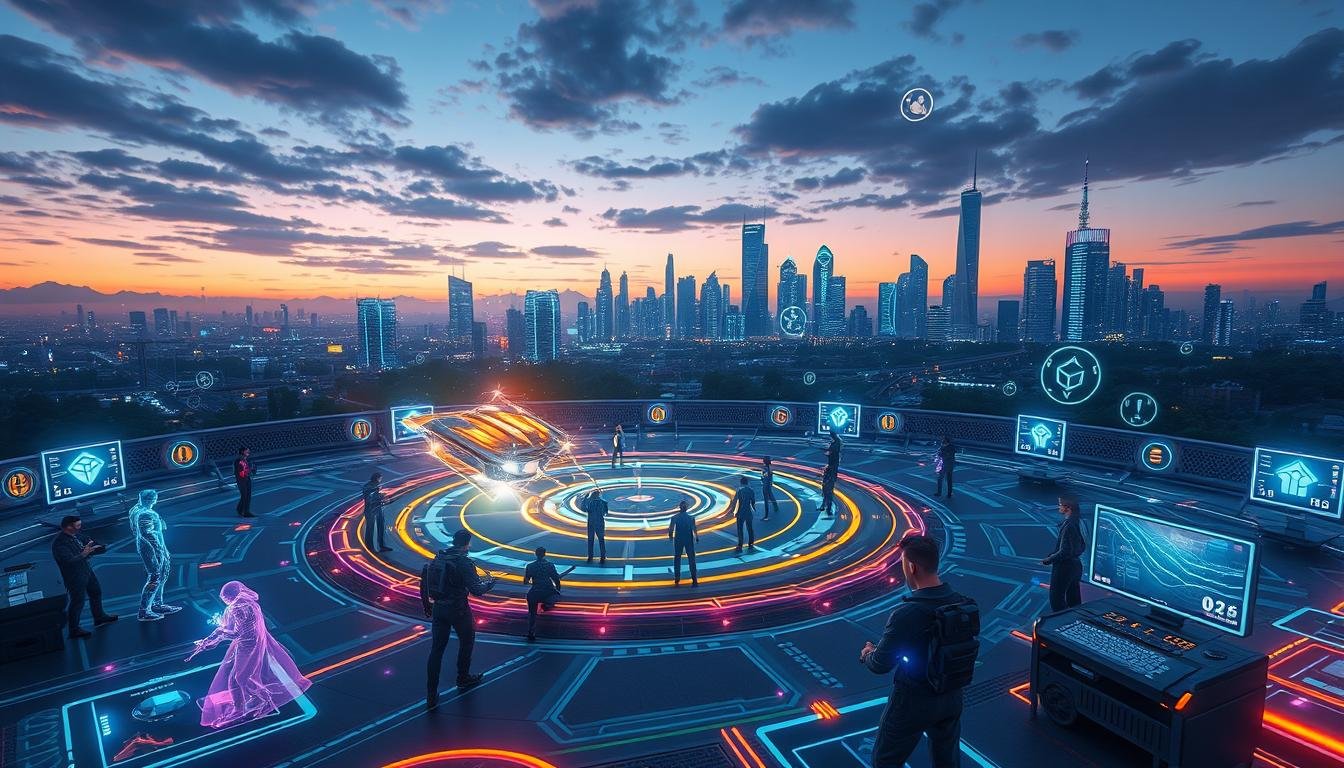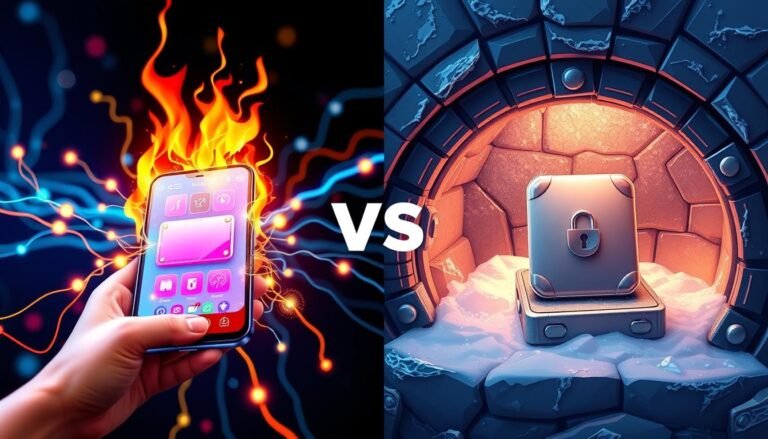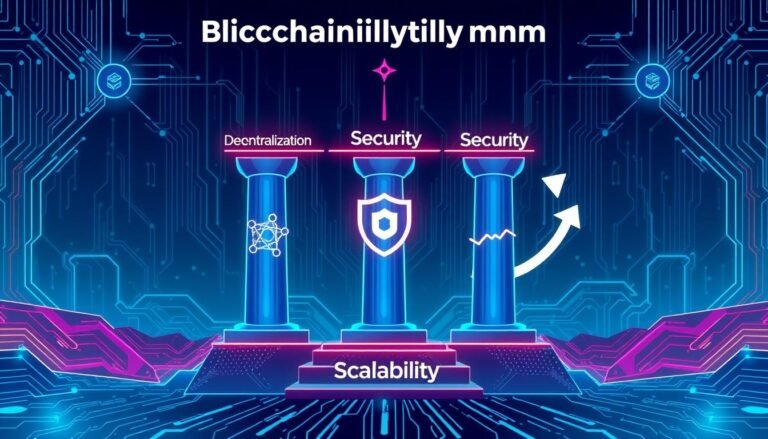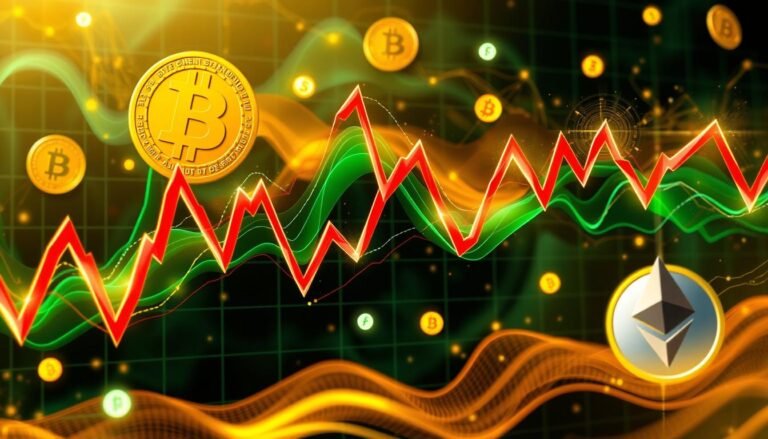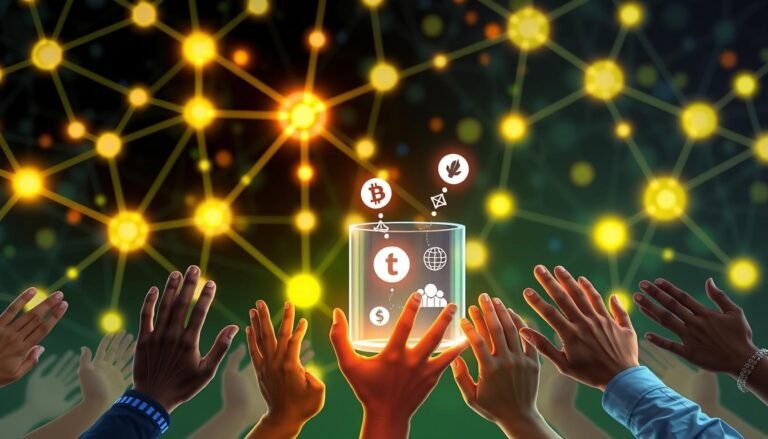Blockchain Gaming: Play-to-Earn Revolution
The video game world has changed a lot. Now, games offer amazing visuals, deep stories, and big online communities. The play-to-earn (P2E) movement, powered by blockchain, is changing gaming even more. P2E lets players own game items as non-fungible tokens (NFTs), giving them real value.
Players can trade or sell these items for cryptocurrency. This can then be turned into real money. This new way of gaming is all about player ownership and value.
The mix of P2E and online casinos is opening up a new area. Here, blockchain makes games fair and introduces new features like NFTs. This new mix is changing the old gaming world. It combines digital and physical worlds through blockchain, crypto rewards, and NFTs.
Key Takeaways
- The play-to-earn (P2E) revolution is transforming the gaming industry by empowering players to own in-game assets as non-fungible tokens (NFTs).
- The ownership economy enabled by P2E allows players to trade or sell their assets on marketplaces for cryptocurrency, which can then be converted to real money.
- The intersection of P2E and online casinos is creating a new frontier, where blockchain technology is used to offer provably fair games and unique mechanics like NFT-based collectibles or tokens.
- The decentralization of gaming through P2E models is disrupting traditional revenue models in the industry, leading to a more equitable and transparent ecosystem.
- The play-to-earn revolution is contributing to the widespread adoption of cryptocurrency, particularly in developing countries where it provides a viable alternative income stream.
The Rise of Play-to-Earn Gaming
The play-to-earn (P2E) revolution is changing the gaming world. It lets players own their in-game items as non-fungible tokens (NFTs). Blockchain technology makes sure these items are safe and can’t be copied or lost.
P2E games cover many genres, like card games and role-playing. They offer players a chance to earn cryptocurrency for playing. This is a big change from traditional games where you spend time and money without getting much back.
The Play-to-Earn Concept
The P2E model lets players earn assets, cryptocurrencies, or tokens by playing. This is different from old games where you spend a lot but get little in return. Thanks to blockchain, players can own their game items, opening up new ways to make money.
They can rent out rare items or trade virtual goods across games. This keeps their ownership safe.
Ownership and Asset Control
The shift in asset control in P2E games has led to a new market for in-game items. Players can now make money from their rare items. This creates a new way to earn.
Places like NFT Marketplaces help players trade these Crypto Rewards. This lets them join the Web3 Gaming world more actively.
| Game | Gameplay | Player Earnings |
|---|---|---|
| Axie Infinity | Collect, breed, and battle unique digital creatures called Axies (NFTs) | Players can earn the game’s native token, SLP, which can be exchanged for cryptocurrencies or fiat currency |
| The Sandbox | Explore and build in a virtual 3D world, creating and monetizing digital assets as NFTs | Players can earn the SAND token by participating in the game’s economy, including renting virtual land or selling in-game items |
| Gods Unchained | Collect and trade digital trading cards, which are NFTs, in a competitive card game | Players can earn the GODS token by winning matches, which can be used to purchase new cards or exchanged for other cryptocurrencies |
Play-to-Earn Games: A New Business Model
The rise of GameFi Ecosystems has changed the gaming world. Games like Axie Infinity, Decentraland, and The Sandbox have introduced a new way to play. Players can earn real-world token Economics and cryptocurrencies by playing.
In these Blockchain Games, players get tokens or NFTs as rewards. These can be traded for real money. This is especially helpful in areas with few job options.
This new model helps both players and game makers. Players get to help decide how the game is run. This makes them feel like they own a part of the game.
“Blockchain gaming has introduced a new paradigm where players are not just passive consumers, but active participants in the game’s economy and development.”
This new way of gaming could make games more sustainable. Players can earn while playing, making the game world more engaging.
The mix of Token Economics and player power in Blockchain Games is changing gaming. It’s making games where players can earn and have fun at the same time. This is good for both players and communities.
Blockchain Gaming: Play-to-Earn Revolution
Intersection of P2E and Online Casinos
The play-to-earn (P2E) model is changing the online casino world. Platforms like Decentral Games use blockchain for fair games. Players can check if the games are random, which builds trust.
P2E casinos also offer unique features like NFTs. These can be used in games, making them more fun and rewarding. This mix of P2E and online casinos is opening up new possibilities in gaming.
Empowering Game Developers and Communities
Blockchain gaming is helping game developers and communities. It lets players help decide how games are made. This makes games more personal and fun.
Blockchain also lets developers fund new games through Initial Game Offerings (IGOs). This makes game development more open and creative. It helps bring new and exciting games to Web3 Gaming.
| Benefit | Description |
|---|---|
| Decentralized Governance | Players can participate in decision-making processes, shaping the direction of the games they enjoy. |
| Democratized Game Development | Blockchain technology enables developers to host Initial Game Offerings (IGOs), allowing for more diverse and innovative projects to emerge in the Web3 Gaming space. |
NFT Marketplaces and Crypto Rewards in blockchain gaming empower developers and players. They create a fair and open Ownership Economy in gaming.
“Blockchain gaming is ushering in a new era of player empowerment, where gamers can truly own their in-game assets and shape the future of the games they love.”
Benefits of Blockchain in Gaming
Blockchain technology has changed the gaming world. It brings digital ownership and clear records. Players can own their in-game items securely, without worry of loss.
This makes players more involved and happy. They feel they have a real stake in the game world.
Secure Ownership and Transparency
Blockchain makes sure players own their game items safely. It keeps a record of all transactions, making games fair and secure. This builds trust and honesty in Web3 Gaming.
Interoperability and Cross-Platform Assets
Blockchain lets players use their items on different platforms. This makes virtual goods more valuable and useful. Players can easily move their NFT Marketplaces and Crypto Rewards between Blockchain Games.
This freedom to trade or sell items empowers players. It’s a big step forward for the gaming world.
Blockchain has made gaming better. It gives players secure ownership, clear transactions, and the chance to use their items everywhere. This change has made the gaming community more involved and powerful.
The Impact of Play-to-Earn Gaming
The play-to-earn (P2E) gaming revolution is changing the digital entertainment world. It offers new ways for economic empowerment and income. Players now own their in-game assets, linking gameplay to real money rewards.
In areas with few job chances, P2E games offer a way to earn extra money. Players can get cryptocurrencies or sell virtual items for cash. This gives them a real reason to play GameFi ecosystems.
P2E gaming is changing how we see games and players. It’s making players more economically motivated. As it grows, it could change digital entertainment and society in big ways.
Economic Empowerment and Alternative Income
Play-to-earn games are changing the gaming world. They let players earn crypto rewards and wealth through their games. This helps people, especially in poor areas, earn more and be financially stable.
- LuckHunter (LHUNT) presale at $0.001, with analysts predicting a potential 400% rise upon listing and a 1000x ROI by 2025.
- Axie Infinity (AXS) with over a million active users in 2021, offering real-world rewards through its native tokens AXS and SLP.
- The Sandbox (SAND) anticipating exponential growth, with SAND tokens potentially delivering 1000x returns by 2025 due to expanding metaverse trends.
- Gods Unchained (GODS) featuring every card as an NFT, allowing players full ownership and strong return potential by 2025.
- Alien Worlds (TLM) offering a unique metaverse experience with earning opportunities through mining and in-game missions.
Play-to-earn games are easy to access, needing only a smartphone. This makes earning money possible for people worldwide. It lets them join the ownership economy and build their financial future.
“Play-to-earn games are creating income opportunities for many individuals, including those from developing nations, where the earnings from these games can surpass local wage standards and bring significant changes to players’ financial status.”
The Role of Mini-Games in the P2E Landscape
In the world of play-to-earn (P2E) gaming, mini-games are key. They are short, fun, and easy to start, welcoming many players. Their quick rewards fit well with the P2E model.
Low Entry Barrier and Instant Gratification
Mini-games are quick, simple, and fun. You can earn in-game money or NFTs fast. This makes them great for both casual and serious gamers.
Building Communities and Fostering Innovation
Mini-games help build gaming communities. They bring players together through competition and social interaction. They also let developers try new ways to make money, pushing the P2E scene forward.
Using blockchain, mini-games offer a safe and clear gaming experience. As the P2E world grows, mini-games will play a bigger role. They’ll help new players get into Hyper-casual P2E and Skill-based Tournaments. They’ll also help with Social Gaming and finding new ways to make money and balance games.
“Mini-games in the P2E landscape offer a unique blend of instant gratification, community building, and economic innovation, paving the way for a more accessible and engaging blockchain gaming experience.”
Challenges and Future Outlook
The blockchain games and play-to-earn gaming world is exciting but faces challenges. One big worry is volatility. The value of in-game assets can change a lot, making it hard for players to know what to expect financially. Also, adding blockchain to games needs a lot of tech know-how, which can stop some developers.
Scalability is another problem. Blockchain networks must handle lots of data for big multiplayer games. But, as blockchain gets better and more developers join, these problems should get solved. The future of play-to-earn gaming looks good, with more people getting into it and changing how we enjoy digital games.
Volatility and Scalability Concerns
The ups and downs of in-game assets and cryptocurrencies can make it hard for players to count on their earnings. This uncertainty makes it tough for players to see these earnings as a steady income. Also, blockchain networks’ scalability issues can stop play-to-earn games from growing big and complex.
Mainstream Adoption and Integration
Even though play-to-earn gaming is getting more popular, getting blockchain into mainstream games is tough. Many developers don’t have the skills or resources to add blockchain to their games. Also, worries from players and regulators about unfairness or too much financial risk might slow down adoption.
As play-to-earn gaming keeps growing, solving these problems is key for its success and wider adoption. With blockchain getting better and more teamwork between developers, studios, and gamers, the future of play-to-earn gaming looks bright. It has the chance to change how we enjoy and get value from digital games.
Conclusion
The play-to-earn revolution, powered by blockchain technology, is changing the gaming world. It lets players own their in-game assets with non-fungible tokens (NFTs). This creates new economic chances, empowering players and building a more active gaming community.
The mix of P2E and online casinos shows the wide range of possibilities. Mini-games also play a big role in the P2E world. Despite challenges like volatility and scalability, P2E gaming’s future looks bright.
It has the power to change how we enjoy digital entertainment. As blockchain tech gets better and more developers join, we’ll see more exciting P2E games. These games will change the gaming world and beyond.
Axie Infinity is a great example, letting players in the Philippines earn cryptocurrency. This can be turned into real money. The global blockchain gaming market is expected to hit $10.7 billion by 2026, growing fast.
Source Links
- Blockchain Gaming: Play to Earn
- Play-To-Earn: The New Crypto Paradigm Redefining The Future Of Work
- The Rise of the Play-to-Earn Revolution: How Blockchain is Transforming Gaming – Colombo Telegraph
- The Rise of Blockchain in Gaming: Play-to-Earn and the Future of the Metaverse
- The Blockchain Gaming Revolution: Unlocking Title, Play-to-Earn, and Devolved Economies
- Play-to-Earn Revolution: Building Sustainable Gaming Economies Post-Axie Infinity
- The Best Web3 and Play-to-Earn Games [2024]
- Decentralized Gaming and the Play-to-Earn Economy: Blockchain’s Revolution in Gaming
- Play-to-Earn Revolution: How Mini-games are Shaping the Future of Crypto Gaming
- Anarchy Games Transforms Battle Royale with ‘Play-to-Earn’ Revolution
- How Blockchain In Gaming Is The Next Big Thing ?
- Blockchain in the Gaming Industry | Uniathena
- Best Play-to-Earn Games Cryptos That Will Make Gaming Profitable – Earn Up To 100x Exciting Returns! – Brave New Coin
- Play-to-Earn Success Tales and Broader Impacts (Explained)
- Play-to-Earn: Web3 the way it’s meant to played | Chainstack Blog
- Tokenizing GameFi: The Future of Digital Assets in Gaming
- Play-to-Earn: Everything You Need To Know – GamesPad
- Blockchain Game Development
- Block Chain in Gaming: Revolution of Play-to-Earn
- Blockchain in Gaming: Revolutionizing How We Play and Earn
- The Rise of Play-to-Earn Gaming: How Blockchain is Transforming the Gaming Economy
- Play-to-Earn Games: Blockchain to Transform the Gaming Industry
- The Future of Blockchain Gaming: Beyond Play-to-Earn
